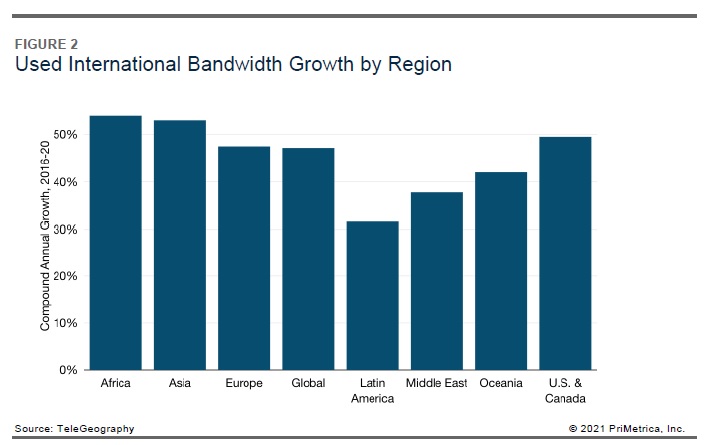
WASHINGTON, D.C. — International bandwidth demand connected to and between the U.S. and Canada has more than doubled every two years between 2016 and 2020, according to new research from TeleGeography, a global telecommunications market research and consulting firm with offices in the U.S. and U.K.
TeleGeography’s global bandwidth research also found total international bandwidth has more than quadrupled during the same time period, exceeding 2 Pbps (petabits per second – one petabit per second equals one quadrillion bits per second, or 1,000 terabits per second).
“While mature markets typically grow slower than developing ones, that’s not the case when it comes to global bandwidth demand,” said Anahí Rebatta, senior analyst at TeleGeography, in a press release.
“Content providers like Google, Facebook, Amazon, and Microsoft are huge drivers for bandwidth demand across the globe. Their top priority is to link their data centers and major interconnection points, meaning they often take tremendous capacity on core routes, while focusing less on secondary long-haul routes,” added Rebatta.
According to TeleGeography’s research, hyperscale content providers accounted for 91% of used capacity on the trans-Atlantic route in 2020, but just 12% on the Europe-East Asia route.
The global Covid-19 pandemic has amplified the critical role the international bandwidth market plays in keeping the world connected and moving forward, says the press release. “To that end, demand has accelerated across not just the U.S. and Canada, but nearly all global networks, with operators feeling this increase most acutely in the access networks.”
To meet the demand for bandwidth internationally, companies are investing in existing networks and new infrastructure, said Rebatta.
“The lit capacity on major submarine cable routes is soaring to keep pace with demand. Between 2016 and 2020, lit capacity more than tripled on many routes. The swiftness of growth was the most rapid on the trans-Atlantic route, where lit capacity increased nearly five-fold between 2016 and 2020.”
The 2021 executive summary of TeleGeography’s Global Bandwidth Research Service can be downloaded here.




